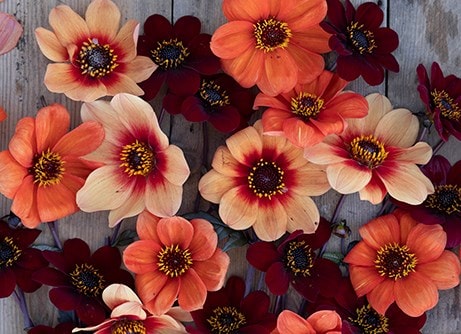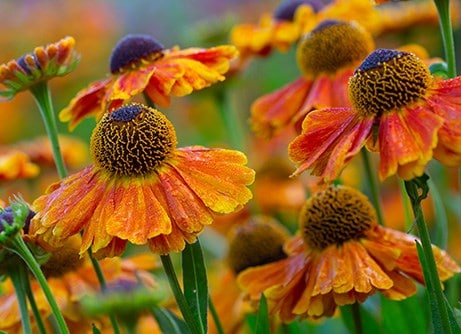
‘White Ladies’ is perfect for a blast of late summer blooms and top-up of nectar for pollinators. Masses of double daisy-like pure white flowers with yellow centres appear on upright stems clothed with dark green, glossy foliage from August to October.
How to care for Symphyotrichum novi-belgii White Ladies:
Asters prefer moist but well-drained, loamy soil rich in organic matter. If your soil is heavy or clay-based, improve it by incorporating compost or well-rotted manure. Consistent moisture is important, especially during dry spells.
Space the plants about 45-60cm (18-24in) apart to allow room for growth and ensure good air circulation. This is especially important for Symphyotrichum novi-belgii, which can be more prone to mildew in late summer.
Insert twiggy prunings or slender canes early in the season to give support as the plants grow. Taller cultivars may flop without it, especially in exposed areas.
To encourage bushier growth and more flowers, pinch back the stems when the plants are about 15-20cm (6-8in) tall - you can also remove spent flowers to extend the blooming period.
Avoid overhead watering where possible to help prevent mildew. Water at the base of the plant to keep the foliage dry.
Leave the top growth on through winter to protect the crown and provide shelter and food for wildlife. Cut back to ground level in late winter or early spring when new growth appears.
Apply a 5-7cm (2-3in) mulch around the base in spring to help retain moisture and suppress weeds. Keep mulch clear of the crown to prevent rotting.
Space the plants about 45-60cm (18-24in) apart to allow room for growth and ensure good air circulation. This is especially important for Symphyotrichum novi-belgii, which can be more prone to mildew in late summer.
Insert twiggy prunings or slender canes early in the season to give support as the plants grow. Taller cultivars may flop without it, especially in exposed areas.
To encourage bushier growth and more flowers, pinch back the stems when the plants are about 15-20cm (6-8in) tall - you can also remove spent flowers to extend the blooming period.
Avoid overhead watering where possible to help prevent mildew. Water at the base of the plant to keep the foliage dry.
Leave the top growth on through winter to protect the crown and provide shelter and food for wildlife. Cut back to ground level in late winter or early spring when new growth appears.
Apply a 5-7cm (2-3in) mulch around the base in spring to help retain moisture and suppress weeds. Keep mulch clear of the crown to prevent rotting.
Flowering period:
- Jan
- Feb
- Mar
- Apr
- May
- Jun
- Jul
- Aug
- Sep
- Oct
- Nov
- Dec
Eventual height:
0.9m
Eventual spread:
0.5m
Position:
Full sun / light shade
Rate of growth:
Average
Soil:
Moderately fertile, moist, well-drained soil
Hardiness:
Fully hardy
-
This perennial dies back to below ground level each year in autumn, then fresh new growth appears again in spring.
Product options

9cm pot
£9.99
In stock
(shipped within 2-3 working days)
(shipped within 2-3 working days)

3 × 9cm pots
£19.99
£6.66 each
In stock
(shipped within 2-3 working days)
(shipped within 2-3 working days)

6 × 9cm pots
£36.99
£6.17 each
In stock
(shipped within 2-3 working days)
(shipped within 2-3 working days)
1
Delivery options (pick your preferred option at checkout)
Standard Delivery£5.99
Named Day Delivery£10.99
Goes well with
Geranium Rozanne ('Gerwat') (PBR)
RHS Chelsea Flower Show Plant of the Centenary
From £12.99
View options
| 2 litre pot | £19.99 |
|
| 9cm pot | £12.99 |
|
| 3 × 9cm pots | £29.99 |
|
| 6 × 9cm pots | £49.99 |
|
| 3 × 2 litre pots | £49.99 |
|
View details










